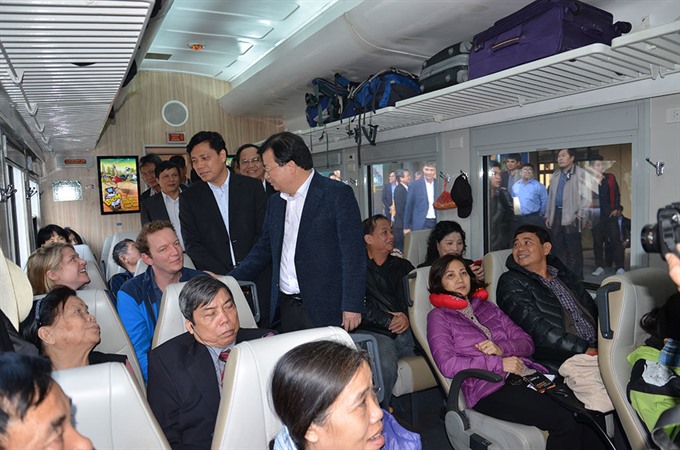 Society
Society

The domestic railway sector is urged to fix its current infrastructure weaknesses to raise the capacity of carrying passengers to at least 13 per cent and loading goods to at least 14 per cent by 2020 following Government targets.
 |
| Deputy Prime Minister Trịnh Đình Dũng visits to several train stations in Hà Nội. — Photo tuoitre.vn |
HÀ NỘI — The domestic railway sector is urged to fix its current infrastructure weaknesses to raise the capacity of carrying passengers to at least 13 per cent and loading goods to at least 14 per cent by 2020 following Government targets.
To reach the goals, Deputy Prime Minister Trịnh Đình Dũng, during his visit to several train stations in Hà Nội and then working with the Việt Nam Railway Corporation, tasked the sector to quickly upgrade its major railway stations.
It was ordered to attract more investment capital from the private sector to connect the railway infrastructure system with domestic and even regional sea ports for conveniently transporting both passengers and goods, he said.
Dũng said his requirements came after the domestic railway sector was found to be lagging behind, with loading capacity only meeting about 2 per cent of demand of passengers and goods compared to road and air travel.
The current railway infrastructure system also failed to link with sea ports or major industrial processing zones, he said.
Additionally, maintaining and repairing incidents on the railway was still slow and fatal railway accidents reportedly occurred mainly at level-crossings, he said.
Dũng said the transport sector failed to point out a clear and consistent direction to develop the railway sector.
According to the corporation, low investment to develop the railway sector was exacerbating the situation.
Data from the corporation showed that investment for the railway sector only accounted for nearly 3 per cent of total investment for the transport sector.
It was estimated to be VNĐ4.8 trillion (US$211 million) of the total VNĐ140 trillion ($6.1 billion) in the period 2001-10, and VNĐ11 trillion ($484 million) of the total VNĐ484 trillion ($21 billion) during the period 2011-15.
Deputy Minister of Transport Nguyễn Ngọc Đông said the current investment capital spending on the railway sector each year only met about 40 per cent of demand.
Đông suggested that the Government give priority to pouring medium-term investment capital to develop the railway infrastructure in the near future.
Vũ Tá Tùng, general director of the corporation said weak infrastructure was the main obstacle for raising loading capacity and train speed.
Tùng also said the railway sector was facing severe competition with other means of transport, especially low-cost airlines.
Thus, improving the infrastructure would help the railway sector raise the frequency of trains running, reduce the transport cost and raise competitive capacity, he said.
"However, the most important thing is we are in need of $1.8 billion to make the improvements," he added.
In response to the proposal of raising investment capital for the railway sector, Deputy Prime Minister Dũng said additional investment capital would be spent to develop the railway sector, but the sector was required to ensure effectiveness.
The railway sector stretches throughout the country with a total length of over 3,143 km. The number of level-crossings is estimated to be 6,400. — VNS




